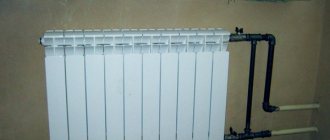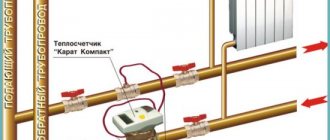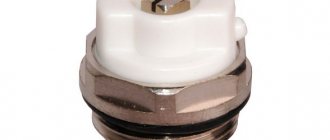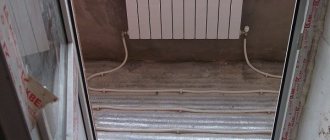When to turn off radiators
There are several situations when you need to turn off the water in the battery:
- in the event of an emergency that threatens to flood your own and neighbors’ homes with hot coolant;
- if you decide to paint the radiator during the heating season;
- when you need to change or wash the battery without blocking the riser;
- you need to limit the flow of heat into a room that is hot in winter.
Radiators that are too hot are the cause of heat and stuffiness in the apartment
Note. Some apartment owners practice shutting off heating radiators for the summer while preserving the coolant. The goal is to protect heating devices from clogging during the autumn start-up of the system, when a lot of rust flows through the pipes. Below we will explain how to do this correctly.
Now the main point: you will never have problems with how to disconnect a radiator from a centralized system if it is connected according to the correct circuit using shut-off valves (ball valves). You will be able to shut off the coolant flow at any time if such a need arises, without disturbing the thermal conditions of adjacent apartments. The shutdown algorithm is simple:
- Close the lower and then the upper valve on the battery.
- If you plan to paint the heating device, then the previous step is sufficient. Wait until the radiator is cold and paint.
- When it is necessary to replace batteries in the middle of winter, before removing each heater, release the pressure through the Mayevsky valve. Then unscrew the bottom plug and carefully drain the water, then unscrew the joints and dismantle the device.
Correct connection of the heating device to the central heating risers
A separate question is how to properly turn on the heating radiator so that there is no air pocket left in it, which prevents maximum heating of the surface and air in the apartment. Here the algorithm is similar: you need to open the lower valve, then the upper one, and at the end release the remaining air using the Mayevsky tap.
The handle stands along the axis of the pipe - the valve is open, across it - closed
Note. If you do the opposite and open the top valve first, you risk leaving some air inside the sections of the device. This is not critical, but the de-airing procedure will have to be repeated several times.
Location of the Mayevsky tap on the heating device
Expert advice
Experts advise that during the heating season, in order to shut off radiators, it is mandatory to use the following devices:
- ball valves;
- bypass with valve;
- drainer;
- thermostat;
- device for removing excess gas.
To shut off the heating radiator in an apartment without harming the neighbors, the best option is to call special services. However, in emergency situations, you should not panic, but immediately turn off the heating. To do this, it is worth studying the existing overlap devices and where they are installed.
To learn how to bleed air from a radiator in a multi-story building, see the video below.
For many people, the heating system is a mystery. After all, it consists of rather complex pipe circuits that are interconnected by batteries in each residential apartment. Therefore, if the pipeline breaks down, everyone living in the house will suffer. That is why every person wants to know how to turn off a heating radiator so that not a single apartment is damaged.
What to do with a stuck ball valve
If ball valves are not rotated for years, they tend to sour and jam. In such a situation, do not try to resolve the issue physically and do not force the “butterfly” with pliers or a gas wrench. It is made of a brittle alloy and will probably break. Proceed like this:
- Unscrew the locking nut and remove the butterfly handle from the stem.
- On most of these valves, you will find a nut under the handle that clamps the plastic seal. Loosen it by turning the wrench half a turn. If there is no nut, go to the next step.
- Take an adjustable wrench or other device that allows you to securely grab the flats on the rod. Without applying much force, turn it as far as possible.
- When you feel resistance, turn the rod back all the way and forward again, trying to turn it a few more degrees. Work carefully and without haste!
- In this way, rotate the valve 90°, then tighten the gland nut and reinstall the handle.
An adjustable wrench can be used to firmly grasp the edges
Advice. If you have WD-40 spray lubricant in your household, apply it to the stem and wait 5-10 minutes before rotating.
Be doubly careful when turning off radiators with soured taps during the heating season. If you hurry too much and apply too much force, you will break off the metal rod or ball, and in the worst case, the valve body will burst. A stream of hot water can shoot out from the crack, which can burn you. While you go down to the basement and close the heating riser, the coolant will cause damage to the interior of the room, and you can roughly guess how much it costs to renovate the apartment now.
If you are not sure of your actions, call a plumber. More information on how to close a jammed ball valve in order to disconnect the radiators is described in the video:
What is required to work safely?
When the apartment is hot enough and the owners want to turn off the heating radiator, then you can consider installing a temperature regulator on the batteries. If there is a bypass, a thermostat is installed on the radiator, which regulates the temperature in the room. If there is no bypass, then you cannot install a regulator, because this can regulate the temperature not only in this apartment, but also in the neighbors on the riser. In such a situation, you just need to replace the heating radiator and install a bypass.
Bypass unit and functions
Using a bypass, repair work can be carried out at any time, even in winter, if hot circulating water is available. You just have to turn off the tap located in front of the radiator. Water will immediately stop flowing into the pipes, and circulation will go through the bypass itself. This will allow the apartment owners not to go down to the basement and not block the common riser.
The device itself consists of pipes having a smaller diameter than the pipes of the outlet and supply lines. The presence of two ball valves allows you to properly shut off the radiator and direct circulating water through the bypass.
The functions of the bypass are to regulate the energy carrier. If the room is very hot, it allows you to shut off the system in it for a while. Then hot water will not flow into the radiator and the room will immediately cool down. When replacing the battery, you need to turn off the water, and open it again after installation.
If there is a failure of water circulation in a system that has an electric pump, the bypass will shut off the supply of hot coolant to the pump. This will happen through the outlet pipe. At the same time, the valve opens, and the water is directed directly through the central pipe, and circulation occurs, but without a pump.
The bypass must be installed together with the battery. But experts also recommend making the bypass pipe on site.
Thermostat: role and capabilities
However, to better regulate the room temperature, you can install a thermostat. Using this device, the battery can be disconnected from the general system when needed. By installing a thermostat, you can save on water costs. After all, if you compare ordinary running water and hot water in a bypass pipe, then the consumption of the second is reduced to 35 percent. This matters when the room is hot.
The thermostat itself is a control valve that controls how much water enters the radiator. There are several positions for such a thermostat. If it is completely open, then water enters the battery at full speed. When the thermostat is closed, no water flows into the radiator at all.
But it’s also worth knowing that the thermostat can only be installed with jumpers. Such models allow water to circulate without obstacles. And they also protect the thermostat itself from any clogging. Jumpers are installed in front of the valve to protect it. After all, if the thermostat gets dirty, it will stop letting water through. Therefore, the jumpers must always remain open. In exceptional situations when the batteries require cleaning, you can temporarily close them.
Drain hole and ball valves
Shutting off the radiator can be made much easier if ball valves are installed on the pipes. With their help it is very easy to carry out any overlap. To do this, just turn the tap and the water will stop flowing into the battery.
The presence of a drain hole or a special tap will greatly simplify the work of shutting off the radiator.
Gas removal device
Do not forget that, even if you turn off the radiators in the room, various chemical processes will continue to occur inside them, as a result of which gases are released. If the radiator is closed, they will not be able to go anywhere. And this can lead to battery rupture. Therefore, it is mandatory to install a gas exhaust device on radiators.
Modern batteries are equipped with such devices. They are automatic and manual. The former remove the accumulation of gases as they appear in the batteries. Therefore, it is possible to turn off heating appliances for the summer, but only if you open the device for gas. Manual valves remove excess gas by turning the valve counterclockwise.
Disabling radiators without fittings
It is no secret that in most apartments to this day there are old cast iron radiators or steel convectors without any shut-off fittings, which makes it impossible to shut them off during the heating season. Moreover, according to the old heating scheme, convectors in high-rise buildings are connected to risers without straight sections - bypasses. Therefore, if an accident occurs with a coolant leak, you must act as follows:
- Try to provide some kind of container to collect hot water. If the stream flows to the side, wrap a thick cloth over the break site so that the water flows along it into a bucket.
- Call the dispatch service of your heating energy supply company and report the accident.
- While the service personnel are getting there, provide them with access to the basement, find the keys, open the door, and so on.
- Try to block the riser yourself.
While your water is flowing onto the floor, your neighbors below have a suspended ceiling turning into a bubble.
A few words about how to properly turn off the heating riser. Find in the basement the heating point of your entrance and vertical pipes embedded in a large-diameter main or into a common collector. Follow where they go to determine the emergency riser, and turn it off with a tap. Contact by cell phone someone in the household who can confirm that the geyser eruption in the apartment has stopped. If you couldn’t find your pipe, close all the valves one by one until you find the one you need.
Attention! Don't try to force yourself on basement valves that are stuck due to rust. When they cannot be closed manually, it is better to wait for a team of plumbers; they will find a way to stop the flow of coolant. Otherwise, a very awkward situation will arise when you also break the main fittings, leaving the apartment building without heat during repairs.
An example of an access heating point and connecting a riser.
It is also worth considering the question of how to shut off the radiator if it is hot in the apartment due to the service provider’s failure to comply with the temperature schedule of the boiler room. It would seem that if there are shut-off valves, the problem is solved by manually closing the taps. But after the temperature in the rooms drops, the valves will have to be opened again. This way you will get tired of turning the taps long before the end of the heating season, so you need to think about how you can adjust the heat output of the radiators. The options are:
- if possible, install a thermostatic valve on each radiator, limiting the flow of coolant and automatically maintaining the set temperature in the room;
- It is nice to cover the heating device with a blank screen with small holes if there are no shut-off valves on the connections.
Important. The ball valve is not a means of adjustment; it is intended only to completely cut off or open the passage of the coolant. In the “half closed” mode it will not give the desired effect and will fail much earlier.
Thanks to worn-out pipelines, district heating systems are notorious for dirty water that quickly clogs small passages. Therefore, ordinary valves with thermal heads will not last long here; you need to buy special valves with increased capacity, which are produced by the well-known brands Danfoss and Herz. How to install them on the connection to the radiator is shown below in the diagram and described in this material.
Radiator thermostat installation diagram
When it’s hot in an apartment in the middle of winter and there are no control valves, residents have no choice but to cover the radiator in the room with a decorative screen. The principle is simple: the radiator will heat the air inside the box, after which the intensity of heat transfer will sharply decrease due to the small difference in the temperatures of the air and the surface. That is, the coolant will give off less energy, and the amount of hot air coming out from under the screen will be limited by the size of the decorative openings. How to assemble and install a nice MDF box on a heating device is shown in the video:
What is required to work safely?
When the apartment is hot enough and the owners want to turn off the heating radiator, then you can consider installing a temperature regulator on the batteries. If there is a bypass, a thermostat is installed on the radiator, which regulates the temperature in the room. If there is no bypass, then you cannot install a regulator, because this can regulate the temperature not only in this apartment, but also in the neighbors on the riser. In such a situation, you just need to replace the heating radiator and install a bypass.
Bypass unit and functions
Using a bypass, repair work can be carried out at any time, even in winter, if hot circulating water is available. You just have to turn off the tap located in front of the radiator. Water will immediately stop flowing into the pipes, and circulation will go through the bypass itself. This will allow the apartment owners not to go down to the basement and not block the common riser.
The device itself consists of pipes having a smaller diameter than the pipes of the outlet and supply lines. The presence of two ball valves allows you to properly shut off the radiator and direct circulating water through the bypass.
The functions of the bypass are to regulate the energy carrier. If the room is very hot, it allows you to shut off the system in it for a while. Then hot water will not flow into the radiator and the room will immediately cool down. When replacing the battery, you need to turn off the water, and open it again after installation.
If there is a failure of water circulation in a system that has an electric pump, the bypass will shut off the supply of hot coolant to the pump. This will happen through the outlet pipe. At the same time, the valve opens, and the water is directed directly through the central pipe, and circulation occurs, but without a pump.
The bypass must be installed together with the battery. But experts also recommend making the bypass pipe on site.
Thermostat: role and capabilities
However, to better regulate the room temperature, you can install a thermostat. Using this device, the battery can be disconnected from the general system when needed. By installing a thermostat, you can save on water costs. After all, if you compare ordinary running water and hot water in a bypass pipe, then the consumption of the second is reduced to 35 percent. This matters when the room is hot.
The thermostat itself is a control valve that controls how much water enters the radiator. There are several positions for such a thermostat. If it is completely open, then water enters the battery at full speed. When the thermostat is closed, no water flows into the radiator at all.
But it’s also worth knowing that the thermostat can only be installed with jumpers. Such models allow water to circulate without obstacles. And they also protect the thermostat itself from any clogging. Jumpers are installed in front of the valve to protect it. After all, if the thermostat gets dirty, it will stop letting water through. Therefore, the jumpers must always remain open. In exceptional situations when the batteries require cleaning, you can temporarily close them.
Drain hole and ball valves
Shutting off the radiator can be made much easier if ball valves are installed on the pipes. With their help it is very easy to carry out any overlap. To do this, just turn the tap and the water will stop flowing into the battery.
The presence of a drain hole or a special tap will greatly simplify the work of shutting off the radiator.
Gas removal device
Do not forget that, even if you turn off the radiators in the room, various chemical processes will continue to occur inside them, as a result of which gases are released. If the radiator is closed, they will not be able to go anywhere. And this can lead to battery rupture. Therefore, it is mandatory to install a gas exhaust device on radiators.
Modern batteries are equipped with such devices. They are automatic and manual. The former remove the accumulation of gases as they appear in the batteries. Therefore, it is possible to turn off heating appliances for the summer, but only if you open the device for gas. Manual valves remove excess gas by turning the valve counterclockwise.
How to shut off batteries for the summer
The purpose of the event is to avoid dirt and rust entering the radiators, which travels along with the coolant through the pipeline network during the autumn start-up of the system, which is important for aluminum and bimetallic batteries with narrow ducts. The method is simple: in the spring you need to close the taps on the connections to the heater, since it is not known whether there is water in the radiators in the summer. Typically, during this period, technical services empty risers and heating appliances in apartment buildings, contributing to the damage of metals by corrosion.
Advice. If you have Soviet or new-style cast iron batteries installed in your apartment, then there is nothing to worry about blockages and corrosion. Cast iron is valuable because it is “friendly” with low-quality coolant, and the flow sections in it are large enough not to become clogged.
The order of the event is as follows:
- Choose a moment when the heating is almost off, but water is still circulating through the pipes. Turn off the taps near the battery (first the lower one, then the upper one).
- When autumn arrives, wait until the heating system starts up. The event is characterized by the familiar murmur of water in the pipes.
- After making sure that the risers are heated, after a couple of days, open the valves and remove air using a Mayevsky tap. During this time, dirty impurities in the coolant will pass through the pipes past your radiators.
Another tip. In the event that you miss the moment of emptying the heating system, still turn off the taps on the battery. In the fall, turn them on 1-2 days after the heating system starts operating, as shown in the video:
There is a myth: if you turn off the battery taps, the hot water will decrease in volume after cooling, creating a vacuum, causing the body of the heating device to crack. This is unreliable information, since compressing water by 5-6% will not create pressure that can destroy the metal. For a cast iron radiator to be damaged, it must reach a value of at least 15 Bar, for a steel radiator it will require over 20 Bar, and aluminum products will withstand 30 Bar.
Which tap should you close?
If it is still difficult for you to figure out and understand which of the taps can be turned on so that it is not so hot, try partially turning off all the taps one after another and see if the riser cools down or if there are complaints from neighbors. Opening the taps back will quickly restore the previous heating level.
In general, we can conclude that no matter what you block, if the temperature at the entrance and exit to the apartment has not changed significantly, then you did the right thing.











